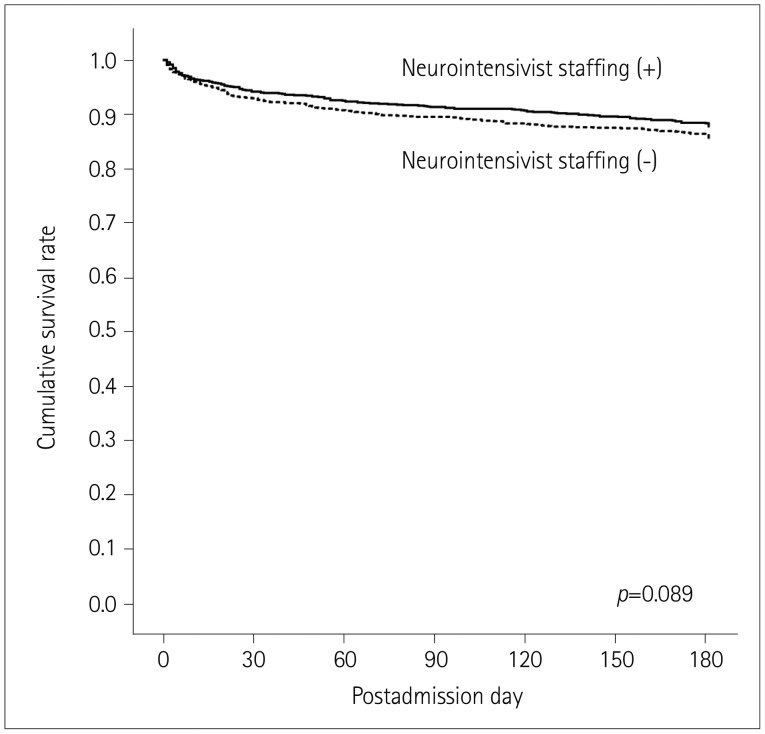J Clin Neurol.
2019 Jul;15(3):360-368. 10.3988/jcn.2019.15.3.360.
Effects of Appointing a Full-Time Neurointensivist to Run a Closed-Type Neurological Intensive Care Unit
- Affiliations
-
- 1Department of Neurology, Asan Medical Center, University of Ulsan College of Medicine, Seoul, Korea. sbjeonmd@gmail.com
- 2Department of Neurology, Jeju National University Hospital, Jeju, Korea.
- 3Department of Pulmonary and Critical Care Medicine, Asan Medical Center, University of Ulsan College of Medicine, Seoul, Korea.
- KMID: 2451121
- DOI: http://doi.org/10.3988/jcn.2019.15.3.360
Abstract
- BACKGROUND AND PURPOSE
To investigate whether appointing a full-time neurointensivist to manage a closed-type neurological intensive care unit (NRICU) improves the quality of critical care and patient outcomes.
METHODS
This study included patients admitted to the NRICU at a university hospital in Seoul, Korea. Two time periods were defined according to the presence of a neurointensivist in the preexisting open-type NRICU: the before and after periods. Hospital medical records were queried and compared between these two time periods, as were the biannual satisfaction survey results for the families of patients.
RESULTS
Of the 15,210 patients in the neurology department, 2,199 were admitted to the NRICU (n=995 and 1,204 during the before and after periods, respectively; p<0.001). The length of stay was shorter during the after than during the before period in both the NRICU (3 vs. 4 days; p<0.001) and the hospital overall (12.5 vs. 14.0 days; p<0.001). Neurological consultations (2,070 vs. 3,097; p<0.001) and intrahospital transfers from general intensive care units to the NRICU (21 vs. 40; p=0.111) increased from the before to after the period. The mean satisfaction scores of the families of the patients also increased, from 78.3 to 89.7. In a Cox proportional hazards model, appointing a neurointensivist did not result in a statistically significant change in 6-month mortality (hazard ratio, 0.82; 95% confidence interval, 0.652-1.031; p=0.089).
CONCLUSIONS
Appointing a full-time neurointensivist to manage a closed-type NRICU had beneficial effects on quality indicators and patient outcomes.
MeSH Terms
Figure
Reference
-
1. Wijdicks EF. The scope of neurology of critical illness. Handb Clin Neurol. 2017; 141:443–447. PMID: 28190429.
Article2. Diringer MN, Edwards DF. Admission to a neurologic/neurosurgical intensive care unit is associated with reduced mortality rate after intracerebral hemorrhage. Crit Care Med. 2001; 29:635–640. PMID: 11373434.
Article3. Josephson SA, Douglas VC, Lawton MT, English JD, Smith WS, Ko NU. Improvement in intensive care unit outcomes in patients with subarachnoid hemorrhage after initiation of neurointensivist co-management. J Neurosurg. 2010; 112:626–630. PMID: 19731990.
Article4. Samuels O, Webb A, Culler S, Martin K, Barrow D. Impact of a dedicated neurocritical care team in treating patients with aneurysmal subarachnoid hemorrhage. Neurocrit Care. 2011; 14:334–340. PMID: 21424884.
Article5. Suarez JI, Zaidat OO, Suri MF, Feen ES, Lynch G, Hickman J, et al. Length of stay and mortality in neurocritically ill patients: impact of a specialized neurocritical care team. Crit Care Med. 2004; 32:2311–2317. PMID: 15640647.
Article6. Varelas PN, Eastwood D, Yun HJ, Spanaki MV, Hacein Bey L, Kessaris C, et al. Impact of a neurointensivist on outcomes in patients with head trauma treated in a neurosciences intensive care unit. J Neurosurg. 2006; 104:713–719. PMID: 16703875.
Article7. Lim CM, Kwak SH, Suh GY, Koh Y. Critical care in Korea: present and future. J Korean Med Sci. 2015; 30:1540–1544. PMID: 26538995.
Article8. Marcolini EG, Seder DB, Bonomo JB, Bleck TP, Hemphill JC 3rd, Shutter L, et al. The present state of neurointensivist training in the United States: a comparison to other critical care training programs. Crit Care Med. 2018; 46:307–315. PMID: 29239885.9. Song HK, Lee BI, Lee JH, Lee KS, Whang SH. Status of neurocritical care in Korea: a nationwide questionnaire survey. J Neurocrit Care. 2013; 6:82–86.10. Varelas PN, Conti MM, Spanaki MV, Potts E, Bradford D, Sunstrom C, et al. The impact of a neurointensivist-led team on a semiclosed neurosciences intensive care unit. Crit Care Med. 2004; 32:2191–2198. PMID: 15640630.
Article11. Chowdhury D, Duggal AK. Intensive care unit models: do you want them to be open or closed? A critical review. Neurol India. 2017; 65:39–45. PMID: 28084236.12. Watson GA, Alarcon LH. Intensivists: don't quit your day job⃛ yet! Crit Care. 2010; 14:305. PMID: 20377922.13. Pronovost PJ, Angus DC, Dorman T, Robinson KA, Dremsizov TT, Young TL. Physician staffing patterns and clinical outcomes in critically ill patients: a systematic review. JAMA. 2002; 288:2151–2162. PMID: 12413375.14. Van der Sluis FJ, Slagt C, Liebman B, Beute J, Mulder JW, Engel AF. The impact of open versus closed format ICU admission practices on the outcome of high risk surgical patients: a cohort analysis. BMC Surg. 2011; 11:18. PMID: 21861878.
Article15. American Thoracic Society. Infectious Diseases Society of America. Guidelines for the management of adults with hospital-acquired, ventilator-associated, and healthcare-associated pneumonia. Am J Respir Crit Care Med. 2005; 171:388–416. PMID: 15699079.16. Knaus WA, Draper EA, Wagner DP, Zimmerman JE. APACHE II: a severity of disease classification system. Crit Care Med. 1985; 13:818–829. PMID: 3928249.17. Jeong JH, Bang J, Jeong W, Yum K, Chang J, Hong JH, et al. A dedicated neurological intensive care unit offers improved outcomes for patients with brain and spine injuries. J Intensive Care Med. 2019; 34:104–108. PMID: 28460590.
Article18. Ryu JA, Yang JH, Chung CR, Suh GY, Hong SC. Impact of neurointensivist co-management on the clinical outcomes of patients admitted to a neurosurgical intensive care unit. J Korean Med Sci. 2017; 32:1024–1030. PMID: 28480662.
Article
- Full Text Links
- Actions
-
Cited
- CITED
-
- Close
- Share
- Similar articles
-
- Impact of Neurointensivist Co-management on the Clinical Outcomes of Patients Admitted to a Neurosurgical Intensive Care Unit
- Consultation Patterns of Neurosurgical Patients Admitted to Intensive Care Units Vary with Neurointensivist Co-management
- Safety and Feasibility of Percutaneous Dilatational Tracheostomy Performed by a Neurointensivist Compared with Conventional Surgical Tracheostomy in Neurosurgery Intensive Care Unit
- Impact of Neurointensivist Co-Management in a Semiclosed Neurocritical-Care Unit
- Management of Common Arrhythmia in the Neurological Intensive Care Unit


